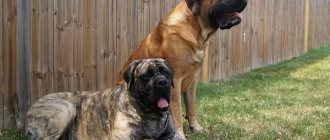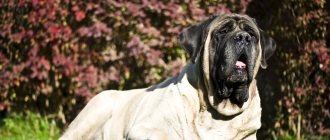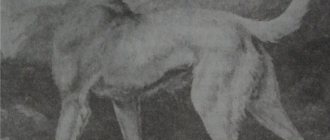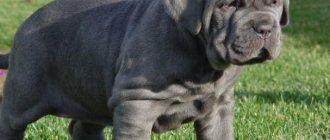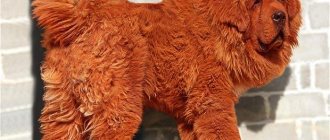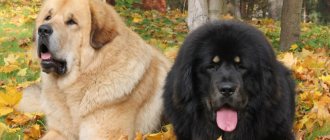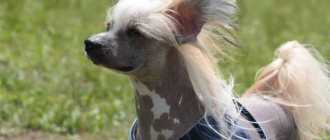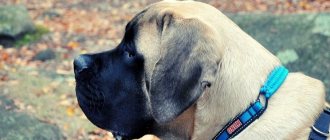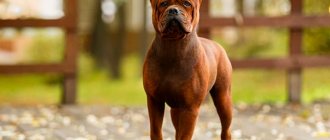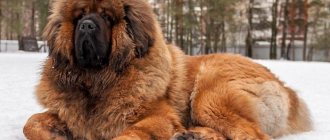Tibetan Mastiff (other names: “herding Tibetan mastiff dro-hi”, “Zang-Khyi”, “Bho-thia”, “ke-khor”, Tibetan mastiff , Tibetan Molos) is a large breed of dog, guard, watchman and companion. It is considered a very ancient breed that guarded Tibetan monasteries. Its ancestors served as a working dog, protecting nomadic herders in the valleys of the Himalayas from predators, and helping them overcome difficult journeys. In ancient times, mastiffs could guard entire villages, whose residents highly valued them for their excellent guard qualities.
Tibetan Mastiff photo
Pros and cons of the Tibetan Mastiff
Pros of the Tibetan Mastiff:
- very smart and quick-witted;
- sociable and love to spend time with their family;
- get along well with children;
- can get along with other animals.
Cons of the Tibetan Mastiff:
- not suitable for novice dog breeders, since raising a dog requires a lot of attention and proper training;
- It is almost impossible to keep in an apartment due to the large size of the animal;
- Dogs become more active in the evening, so early birds will have to rearrange their schedule;
- can be stubborn and capricious, therefore they need the firm hand of the owner;
- The barking of these dogs is quite loud, it can disturb neighbors;
- need frequent physical activity;
- They prefer silence to noisy companies, as they see such situations as a potential threat.
Reviews
Externally, the mastiff is similar to a lion, has the same mane, and has a terrifying appearance. It's better not to keep it in the apartment. The animal is smart and kind, and treats small children with love. Like a big toy for them.
The Mastiff constantly frolics, is always on the move. The dog is easy to train and quickly learns commands. This is a great companion for sports.
The Mastiff is a born guard. You just need to immediately determine that the pet is allowed to guard, otherwise the dog begins to protect everything.
Description of the Tibetan Mastiff
The first European to see a mastiff was the Italian traveler Marco Polo. He described them as follows: this dog is as tall as a donkey, and its voice is like a bass trumpet, like a lion. This is a truly impressive breed. Not only does the Tibetan mastiff resemble a lion in its voice. Its impressive size, stature, thick coat, calm and imposing character - all this makes the Tibetan not just a dog, but a real domestic lion and a symbol of luxury. It is not for nothing that in China the Tibetan mastiff is a sign of prosperity. Every rich Chinese who has a mansion with a garden and an expensive car considers it his duty to have one or more mastiffs. Dogs walk through the green area like good lions and guard the property of their owners.
The Tibetan Mastiff is one of the largest dog breeds. One individual weighs as much as 25 Chihuahuas. These are strong, even powerful, dogs with a muscular build.
Head
Large, its dimensions correspond to the dimensions of the case. The skull is strong and rounded. The occipital protuberance is pronounced and clearly visible.
The muzzle is wide; if you look at the dog from the side, it has the shape of a square. The forehead stands out well.
The nose is wide, the nostrils are large. Black in color, well pigmented.
The jaw is massive and strong, the lips fit tightly to it. Adults may have a pronounced fold on the side. There are no gaps between the teeth; the upper incisors cover those located on the lower jaw. The bite can be scissor or straight.
Eyes
They have an oval shape, stand wide apart from each other and are slightly slanted. The iris is brown and well pigmented. Rich color is considered an advantage. The eyelids fit tightly to the eyeballs.
Ears
Set above the eyes and shaped like a triangle. Directed forward and slightly drooping. If the dog is excited or alert, they may rise and assume a standing position.
Neck
Well muscled, wide and strong. The scruff is clearly visible, there is a slight dewlap. Thick hair grows on the neck, which forms a mane. In females it is more pronounced than in males.
Frame
Strong, with well-developed muscles. The powerful back smoothly transitions into a wide croup. The chest has a pronounced heart shape. The ribs are round in shape. The lower chest line is located below the elbow line.
Tail
It is located quite high, of medium length. Located on the back, it rises when the animal moves. It has long, thick fur.
Limbs
The forelimbs are strong, with well-defined articulation angles. The shoulders are well muscled and sloped. They turn into straight forearms. Elbows point back. Turning inward or outward is considered abnormal. The pasterns are slightly inclined. The paws are large, the toes are pressed tightly together.
The hind limbs stand parallel to each other. This can be clearly seen if you look at the dog from behind. The thighs are elongated, with developed muscles. The knees stand out. Dewclaws are most often removed, but their presence is acceptable. The fingertips can be black or deep brown.
Gait/Movement
The dog’s movements show a combination of power and lightness. The Tibetan Mastiff pushes strongly with its limbs and carries them forward to a sufficient length. Accelerating, the dog moves its paws to the center line of the body. When walking calmly, the dog's movements are noble and leisurely.
Wool
The Tibetan Mastiff has two types of coat. The first one is long and tough. And underneath there is a fluffy, soft and densely packed undercoat. In the spring, the dog begins to shed, and most of it falls out. Long hair forms a beautiful and noble mane on the animal’s neck, which smoothly falls onto the shoulders. There are pronounced fringes on the back of the limbs.
Color
According to the standard, the Tibetan Mastiff can have the following colors:
- rich black, with possible tan marks or their complete absence;
- blue and tan are also acceptable;
- golden hue, from deep red to fawn;
- sable
The purer the shade of the Tibetan Mastiff's coat, the higher the dog's value. The color of tan can be light chestnut or more saturated. A white mark on the chest is acceptable, and there may be “glasses” on the eyes.
Photos of Tibetan mastiffs of different colors
Size and weight
According to the standard, the minimum height for males must be at least 66 centimeters at the withers, and for females - 61. The weight of dogs ranges from 64 to 78 kilograms.
Sacred dogs - genetic treasures of Tibet
Tibet is a sacred and little-known country. A harsh land of snow-capped peaks, desert plateaus and crystal clear cold lakes. It is a stronghold of Mahayana Buddhism, and in 1912-1951 it was an independent state. Now politically Tibet belongs to China, but... Everything is not easy there. Buddhist influence left a certain mystical imprint on local dog breeds and on attitudes towards them. Today you will learn about small sacred rocks, companions of monks and lamas.
Little lion cubs - Lhasa Apso.
All European breeds are mostly several hundred years old. The dogs of Tibet carry such ancient genes that they can be compared with the genetic treasure of the planet. The ancestry of these dogs goes back to the first domesticated wolves in the territories of China and Tibet.
All indigenous mammals of Tibet have common features of adaptation to a cold and harsh climate. This also applies to dogs. All of them are large-headed, large-eyed, with wide-spaced and straight-set eyes. Also present: short neck, thick scruff, abnormally wide chest, powerful bones, shortened limbs. These anatomical features indicate adaptation to the highland climate.
This very serious Tibetan spaniel knows about his wolf genes.
Many Tibetan breeds contain the word "Apso" in their name, which means hairy or bearded. It is made up of two others. "Apa" means "beard" in Tibetan, and "sog-sog" means hairy. Some believe that "apso" is a form of the Tibetan word "rapso", which means "goat-like". There are two types of Tibetan breeds: companion dogs and working dogs.
The attitude towards dogs in Tibet can be called sacred. A dog of any size is considered a member of the family. She is respected and protected. The dog plays a huge role in Tibetan medicine and has symbolic meaning. In Buddhist monasteries there were even sacred dogs that were fed with the meat of deceased monks. In Buddhist beliefs, it is also the “companion of the dead” and the “dog of death.”
1. Lhasa Apso
The Lhasa Apso has very long hair.
The Lhasa Apso is one of the most famous Tibetan breeds. These dogs are about 3 thousand years old. The first mention of them dates back to the 800s BC. DNA analysis revealed the breed as one of the 14 most ancient on the planet.
The dog's name comes from the sacred city of Lhasa, the capital of Tibet. In their homeland they are also called “Apso Seng Kye”, which means guard barking lion. Their long, heavy coat is very soft and fluffy. Lhasa apsos were bred in the vicinity of the capital as companions for monks.
Apso Seng Kye is a guard barking lion. One of the main protective symbols of Buddhism.
The Lhasa Apso puppy is very similar to the Shih Tzu.
They are surprisingly strong and long-lived for such small animals (12-14 years). Lhasas are excellent internal sentries in Buddhist monasteries. They are very sensitive and can warn of any intrusions. It was believed that the small goat-like apso could predict earthquakes, mountain falls and avalanches by its behavior. Buddhists also believe that the soul of a deceased monk, the owner of the dog, can enter the body of a Lhasa Apso. Thus, souls await rebirth in a new human body.
Lhasa Apsos were not allowed to leave the country. This was only possible as a gift from the Dalai Lama. As a gift to the Chinese emperor, the rulers of Tibet presented dogs as messengers of peace and prosperity. Moreover, always in pairs. Since ancient times, it was believed that these dogs bring good luck. So in English there is even a saying “Lucky Lhasa” - happy Lhasa.
Until the mid-60s of the 20th century, the Lhasa Apso and the Tibetan Terrier were one breed, they were called Lhasa Terriers, but later the English Kennel Club separated them. There are two lines of the breed in the world: Western and Tibetan. The Cultural Revolution did not spare these dogs either, as a symbol of everything old. Many Tibetan dogs were killed after the Chinese conquest of the country.
2. Tibetan Spaniel
Tibetan spaniels of different colors.
The Tibetan Spaniel is another ancient guardian of monasteries and a companion for monks. These dogs are approximately 2500 years old. They were also used as live "alarms" in the old days.
In Tibet they are called Jemtse Apso. The word "Jemtse" means to cut, cut, shave. So it can be roughly translated as “clipped apso.” Another name for a dog in Tibetan is simgyin. What does a domestic or indoor dog mean? Doggies also have the name Tibetan prayer dog, and in the English-speaking world they are sometimes called Tibbie. The breed is extremely popular in Scandinavian countries.
Buddhist lama with his spaniels.
They have no genetic relation to hunting spaniels. The name was given when breeding the breed in England in the 20th century because of its similarity to local dwarf spaniels. Relatives of the Chemjo Apso include the Lhasa, Pekingese, Japanese Chin, Shih Tzu, Pug and Tibetan Terrier. These dogs are indeed very similar to the Pekingese, only they have a more “wild” gray-white-yellow coat color with a black mask on the muzzle.
These dogs were animals of a high order. Only monks or the aristocracy could own them. The breed was also considered to represent the guardian lion that Buddha tamed. Dogs were sometimes trained to spin prayer wheels or pray with monks while standing on their hind legs. Chemtse Apso could also only leave Tibet as gifts or traveling with monks. Such sacred gifts were presented to the Chinese emperor and to Buddhist monasteries in other countries. Dogs came to England in the 1890s. Tibetan Spaniels became an internationally recognized breed only in 1987.
Character of the Tibetan Mastiff
The Tibetan Mastiff is calm, devoted to its owner and work. These dogs only from the outside seem fierce, aggressive and dangerous, but in fact they are very affectionate, especially with children, they love to spend time with their family, but at the same time they are not alien to the desire for solitude. They can lie next to their owner for hours. The Tibetan Mastiff is a reliable protector of its family and territory. The monks trusted this breed to protect the monasteries, relying on their power and strong voice.
Tibetan mastiffs have been watchmen for many centuries; they are accustomed to sleeping during the day and being awake at night, so adults are not too active during daylight hours, which cannot be said about puppies. Tibetan Mastiff puppies are very cheerful and cheerful, they love to have fun with their household.
Like all large breeds, Tibetan Mastiffs take a long time to mature, for this reason they can remain playful and carefree for up to 3-4 years. At the same time, constant growth requires a lot of strength from them, so puppies sleep a lot and soundly. The Mastiff will only obey with proper training, which allows man and dog to understand each other. This is a rather capricious dog, you should not expect unquestioning obedience from it, but you can teach it basic commands.
When you first meet an adult Tibetan Mastiff, you may get the impression that this is a self-confident, calm and independent animal. And this opinion will be completely justified. This dog has a very pronounced sense of self-esteem. Therefore, he will demand an appropriate attitude towards himself. There is no nervousness in the character of this giant. Cowardice or unreasonable aggression is considered a vice. The Tibetan Mastiff is reserved in its emotions. He behaves like a real king, so he does not allow himself to make a fuss over trifles.
This breed has the instincts of guarding its territory flowing in its blood. After all, these are the skills that have been cultivated in her since ancient times. This is also the reason why dogs become more active at night. During the day, they prefer to sleep and gain strength so that they can take up their guard post at night. You shouldn't punish your dog if it barks or makes noise when you go on vacation. A Tibetan Mastiff may start barking if it hears a suspicious noise or rustling noise that it perceives as a potential danger. This should be taken into account if your neighbors have a negative attitude towards this behavior of the dog, because its loud barking will be heard throughout the area.
The Tibetan Mastiff will be wary of strangers. Especially when its owner is nearby. But a giant will never show aggression unless there is a clear reason for it. Rest assured, in case of danger, not a single movement of an uninvited guest will escape this skillful guard. One can only envy this dog’s intuition. He literally sees right through people.
The Tibetan Mastiff is unsociable, so he does not approve of large and noisy companies. It is unlikely that your pet will be able to put up with constant guests in your home. After all, he considers him his own too. This also applies to children. If he perceives his little owners as friends, then he will be wary of their friends. Especially if children get into active games and fights. The dog may regard this situation as a potential threat to his family members. If he comes to their defense, it will be dangerous, given the large size of the animal.
In relation to other domestic animals, the Tibetan Mastiff can occupy a dominant position. The exception will be those pets who grew up with the dog. Then he will accept them into his “flock”. Otherwise there will be rivalry.
Don't let your dog get bored. These giants can begin to destroy everything that catches their eye. If you want to keep your area and furniture intact, make sure your Tibetan Mastiff has plenty of toys and exercise. He will happily chase a Frisbee, run after a bicycle, or roll around in the snow.
Hurry up, choose a box and find out what gift awaits you
Discount on pet insurance
Promo code copied to clipboard
Other largest dogs
In addition to Hong Dong, there are several other representatives of the Tibetan Mastiff breed, which are larger in size than the rest of their brothers.
Nicknamed Chief
This representative of the breed became known to the world in 2012, when it was sold at the Chinese exhibition for 1 million 200 thousand dollars.
At the age of 2 years, the length of the dog was 150 cm, and the height at the withers was 80 cm . In appearance, the dog resembles a black bear with brown markings.
The owner of Chief claims that the dog has a unique ability - he is able to open absolutely any locks.
Using only his front paws and teeth, Chief can pick absolutely any lock in just 5-10 minutes..
In a similar way, the dog released all the inhabitants of the dog kennel, as a result of which the kennel staff had to spend almost the entire day catching all the dogs.
Lio Chang
Today, the largest representative of Tibetan mastiffs is considered to be Hong Dong, weighing 113 kg, but there is an opinion that back in the 20th century there lived a dog named Lio Chang, whose weight was 120 kg.
Little is known about Lio Chang, since at that time the Guinness Book of Records had not yet been published. All that is known for certain is that the main Chinese archive contains photographs of this record holder.
Education and training
These are wayward dogs - not for novice dog owners. They differ from other breeds in their aloof character, absent-minded attention, calmness and some immaturity. It is difficult to bribe them with goodies; they do not respond to harsh commands. Just remember that these dogs have been guarding Tibetan monks for hundreds of years and don’t demand instant obedience from them. This breed does not perceive humans as the leader of the pack. Rather, he considers the owner his equal. Due to all these factors, this breed is not suitable for standard training programs. They need a special approach based on trust and love. It is advisable to conduct training under the supervision of a canine handler.
If the dog does not recognize the leader in the owner, then all attempts at training will be in vain. This is due to the stubbornness and pride that are present in the dog's character. The key to success can be your patience. And shouting and rudeness in the process of raising a puppy can turn him into a real uncontrollable monster in the future.
To achieve sustainable results in education, training may take several years. Therefore, the owner of the Tibetan Mastiff needs to be prepared for this in advance. After all, classes will take a lot of time. If it is not there, then the only way out will be lessons from a professional dog handler.
This breed needs imprinting. This is a special set of actions that allow the dog to learn to completely trust its owner. These, at first glance, formidable giants are in great need of affection and approval. It is worth noting that many dogs of this breed have the habit of chewing the clothes of their owners. But there is no point in punishing them for this behavior, because this is how animals express their recognition. So be prepared to sacrifice some of your clothes or shoes.
It is very important to socialize Tibetan Mastiffs from an early age. From the age of three months, the puppy should be around people and other animals more often. This will help the dog understand that he is not the center of the universe. It will be good if your friends start coming to your home so that your pet can get to know them as a child. Then he will not show aggression and wariness towards them when he grows up.
When walking, do not walk on well-trodden paths. Always change your location. This will help your pet not get bored and also help him master new territory. The dog will be better socialized and will become more tolerant of other dogs and animals.
Selection rules
When choosing a Tibetan mastiff, you need to understand that the dog is designed for a spacious area. Active kids carefully explore everything around them; dogs can cause mayhem. You need to be prepared for this.
The future owner should look at the behavior of the puppies. The healthiest representatives of the breed in the litter are fat, active, strong and cocky. Girls get sick less often, they are calmer and learn faster, and become very attached to their owner. Boys are much more active and, due to their restlessness, are more difficult to train at home.
A purebred dog, according to standards, must have a wide muzzle, a powerful jaw, and a tight bite. The bark of both boys and girls is dull and low. But mastiff bitches have less hair, and the undercoat is thicker and more luxuriant. The tail stands high, curls into a ring, and lies close to the back.
Expert opinion
Anna Abramenko
An avid dog lover. Experience in veterinary medicine since 2009.
Ask a Question
It is not recommended to take an adult dog. Most mastiffs recognize only their first owner, although there are exceptions with a good-natured attitude towards the dog.
Caring for Tibetan Mastiffs
To keep a dog you will need:
- Slicker comb and long-tooth comb;
- Tangle cutter or sharp scissors;
- Claw cutter;
- Dry or regular dog shampoo.
The Tibetan Mastiff has a thick, long coat and a very thick undercoat. A dog of this breed must be combed at least once a week and washed when dirty, but at least once a month. During the cold season, the fur becomes thicker, so that by summer Tibetans begin to shed. At this time, the dog needs to be brushed more often. You also need to periodically trim the fur on the paws between the toes. Small stones, burrs and tangles can get stuck there. In advanced cases, this can lead to inflammation. Don’t forget to inspect your dog’s ears and wipe them with a cotton pad, as representatives of this breed may have ear infections.
Show mastiffs require more careful care. Groomers maintain the characteristic appearance of the breed - a shaggy mane and a neat body and muzzle.
If tangles appear on the fur of the Tibetan Mastiff, then it is necessary to use a special tangle cutter. These troubles can occur due to insufficient care of the hair in the ears, neck and paws.
Never use human hair clippers to cut hair. This can cause inflammation on the skin, as well as disruption of body thermoregulation. Don't get carried away with frequent bathing. They can impair the functioning of the sebaceous glands, and the dog will develop a characteristic unpleasant dog odor. It is better to use dry shampoo or simply wipe the contaminated areas with a damp towel. In winter, after bathing, you need to dry your dog thoroughly so that it does not freeze in the fresh air.
To care for your Tibetan Mastiff's claws, you will need a nail clipper. To smooth the nails after shortening, use a nail file. Before the procedure, it is better to steam your paws in warm water to make it easier. It is useful to lubricate the pads on your fingers with oil. This will prevent them from drying out and cracking.
You need to brush your dog's teeth several times a month. A brush or finger attachment is suitable for this. The paste must be used specifically for animals. If tartar has already appeared on the teeth, it can be removed using ultrasonic cleaning at the veterinarian. For prevention, your dog can be given special dental bones. They gently clean the teeth as they chew.
Photo and video review
The Mastiff is a dog with a strong character, self-sufficient, balanced and friendly. To achieve success in raising a pet, you need to devote more time to the dog, treat it with respect, and often take walks in the fresh air. The dog loves freedom and independence and needs outdoor games. Below is a photo and video of the mountain giant.
Conditions of detention
Such a large dog will not be very comfortable even in a medium-sized apartment. A house with a large plot of land is best suited for a Tibetan Mastiff. You also need to walk with your mastiff. Long, quiet walks are suitable for dogs that do not live in a large area.
Mastiffs, like other animals, should not be kept in a cage. This leads to deterioration of health, because, despite the lack of inclination to spend time actively, they also need to splash out energy. However, the mastiff must have an enclosure with a high mesh and a concrete bottom. If the enclosure has no bottom, then the puppies can dig under and run away. If there is no high mesh, adult dogs can jump over the fence and show their guarding qualities on the other side of your territory. It is also important to ensure that the dog does not overheat during the hot season: it should always have the opportunity to hide in a cool place from the heat and direct rays of the sun.
Nurseries
It is better to purchase a dog in special nurseries; they are located both in Russia and abroad.
Among them are:
- "Grand Encore" in Moscow. On the website you can see photographs of adult dogs. Those interested come and meet the puppies. They can be reserved for purchase. Staff help care for their graduates.
- "Giant Pets" in St. Petersburg. In addition to the Tibetan, the Spanish Mastiff and Maine Coons are bred.
- "Bral ma" in Kyiv. The small nursery has been working with the breed since 2007. Employees monitor the health of pets, all of them comply with international standards.
- Eurasian Association of Tibetan Mastiffs in Nilüfer. This is a small Turkish nursery that started operating in 2022.
How to feed Tibetan Mastiffs
When feeding this breed of dog, it is better to give preference to industrial food. The diet should be sufficiently high-calorie and nutritious. Since the Tibetan Mastiff is a large breed of dog, it may be prone to obesity. Therefore, it is better to choose food with a low carbohydrate content. Protein should be the main source of energy.
Industrial food is the ideal choice for a dog. It is developed taking into account all the physiological needs of certain breeds. The food contains all the necessary vitamins, minerals and nutritional components that allow dogs to remain healthy and cheerful throughout their lives. A balanced diet is very important, so when choosing food, be sure to study its composition. It should contain sources of animal fats and carbohydrates, as well as sufficient fiber for digestion. The average caloric intake for a Tibetan Mastiff ranges from 450 to 470 calories per hundred grams of pellets.
An ideal food should contain the following components:
- Proteins. They must be obtained from dehydrated meat;
- Carbohydrates. Rice, corn, wheat and beans. If dogs have allergies, it is better to give preference to rice;
- Fish and eggs;
- Plant fibers and plant extracts;
- Animal fats;
- Vitamins, trace elements and minerals.
Inexpensive feeds contain less meat and are replaced with offal. Therefore, it is better to feed the Tibetan Mastiff with premium and super-premium diets.
Mixed feeding should not be allowed. The diet should consist entirely of dry or wet food. Therefore, do not feed your dog from your table. Smoked, fried, salty and sweet foods can cause digestive problems and also cause more serious health problems in the Tibetan Mastiff.
For puppies, nursing bitches and older dogs, it is better to choose the appropriate food. Portions are calculated based on the manufacturer's recommendations. Overfeeding has a negative impact on dogs and can cause obesity.
Price
The cost of a puppy purchased from a nursery will be approximately fifty thousand rubles. Ads that list a significantly lower price are most likely asking you to purchase a mixed breed. Whether the money saved is worth the risk of bringing a huge animal of unknown origin into your home is up to you to decide. If purebred specimens are studied and characterized by dog handlers, and trainers from the same nursery can approach them, then no one can predict how a mestizo will grow up.
Health
These dogs rarely get sick and live long. Some individuals live up to 17 years. But there are predispositions to such diseases:
- Hip dysplasia;
- Ear infections;
- Thyroid diseases.
It should also be remembered that large breed dogs are susceptible to heart and joint diseases due to their heavy weight.
Don't forget to vaccinate your pet on time. This will protect him from many diseases that are fatal to animals. During the warm season, it is necessary to treat your dog for fleas and ticks. Once a quarter the dog is given anthelmintic.
Interesting facts about the breed
Some interesting information about the Tibetan Mastiff:
- The animal does not have the smell of a dog. The dog is suitable even for allergy sufferers. Dogs shed once a year.
- The breed has incredible strength. There were cases when a giant defeated a snow leopard.
- In ancient times, the voice of the mastiff was considered sacred. The Assyrians believed that mocking a dog was worse than killing a person.
- The Tibetan dog is one of the most expensive in the world (the list also includes Akita Inu, Schippirke, Siberian Husky and Alaskan Malamute). In 2011, a Chinese billionaire purchased a bright red dog for 10 million yuan (almost 100 million when converted to rubles).
Historical reference
Perhaps the Tibetan mastiff can be called one of the oldest breeds on earth. It is believed to be over 2500 years old. The first mention of these dogs dates back to 1121 BC. e. The Chinese book of Shu King mentions that mastiffs guarded monasteries, herds of yaks and the houses of monks. There is no exact information to help determine the origin of the breed. According to some sources, the ancestor of mastiffs was the black Tibetan wolf. And other studies show that the ancestor of the breed was the Chinese watchdogs of merchants who passed through the mountains of Tibet. Still others are completely sure that the Tibetan Mastiff is the ancestor of all modern Molosser breeds. The Molosser group is one of the largest on the planet. It includes bulldogs, boxers, St. Bernards, Rottweilers, etc.
Mastiffs appeared in Europe in the mid-19th century, when the Viceroy of India, Lord Hardinge, gave a Tibetan Mastiff puppy to Queen Victoria of England. Later, Edward VII brought two dogs with him to England. But the first offspring of mastiffs in Europe appeared only at the very end of the 19th century in the Berlin Zoo.
How sensitive guards and loyal family friends won the recognition of humanity
Many countries and peoples have written their pages in the history of the appearance and further spread around the globe of the large Tibetan mastiff.
Chinese scientists who conducted genetic research in the field of separating the DNA chains of a wolf and a dog made the assumption that the process occurred more than 40,000 years ago; the approximate “date of birth” of the breed of interest to us is considered to be a period of more than 50,000 years ago.
The conclusion suggests itself: Tibetan giant dogs are one of the first dog breeds on the planet. The Mastiff's "closest relatives" are the Great Pyrenees, Bernese Mountain Dog, Rottweiler, Saint Bernard and Leonberger.
The ancestors of these breeds quite likely had passionate affairs with each other, which was the reason for the appearance in the future of these well-known large pets.
Throughout the history of mankind, Tibetan Mastiff puppies have become a generous gift or trophy for the winners of certain battles.
The victorious march of the unique breed across the planet began back in the 10th century (it was at this time that the first writings about the unusual family of dogs appeared) and continues to the present day.
A major role in the spread of mastiffs around the world is given to the ubiquitous Romans, great lovers and connoisseurs of the dog breed. The Roman legions, roaming the planet in order to conquer territories and establish their dominance, became the unwitting reason for the first timid appearance of the breed in Europe.
Officially, Western society became acquainted with the Nepalese and Indian guards in 1847, when the English aristocrat Lord Harding presented Queen Victoria with a magnificent male of the Tibetan breed named Siring; this moment became key in the process of spreading mastiffs across the European continent.
Giant dogs came to America a little later, first as a gift to President Eisenhower, then through mass importation from the heavenly lands.
Photos of Tibetan Mastiffs
Who is this breed suitable for?
The power and beauty of this breed is both daunting and captivating at the same time. Many people would like to get such a giant as a pet. But before you get a Tibetan Mastiff puppy, you need to think carefully about this step.
This dog is suitable for owners of large houses with an impressive territory. Since the Tibetan Mastiff cannot be kept on a chain, it will need freedom to move. If you have a poorly fenced area, you will have to build a high and durable fence. It will be easy for a dog of this size to jump over a low fence or dig a hole under it. For apartment owners, even large ones, the Tibetan Mastiff will not be the best option.
You need to spend time actively with your dog. Even if you live in a private house, the dog needs to be walked outside. If you don't pay attention to your dog, it will start to get bored. In order to somehow entertain himself, the dog will begin to play dirty tricks and attract attention to himself.
Photo of Tibetan Mastiff
Raising and training this breed requires a lot of time and effort. It will take endurance and patience. Therefore, this breed is not suitable for people who are hot-tempered and aggressive, as well as too soft and compassionate. It is important for the Tibetan Mastiff to feel like a leader in its owner.
The dog will have no problems with children. She will become their big plush friend. But if there are very young children in the family, then you need to make sure that the dog does not inadvertently injure them. He may accidentally crush the baby with his body weight or knock him down.
You need to spend time caring for your dog. If you don't take care of her fur, it will get matted. They not only spoil the dog’s appearance, but also cause him inconvenience. Talk to your neighbors in advance and warn them that you are getting a Tibetan Mastiff. After all, his loud barking can disturb them. If you wake up at dawn and go to bed early, you should be prepared for the nocturnal activity of these dogs. It is in the evening that they prefer to communicate with their owners.
Fans of noisy parties will be disappointed that the dog will not share their hobbies with them. Representatives of this breed prefer silence and solitude.
Anyone who gets a Tibetan mastiff must be prepared to spend money on its food. To feed such a bear cub, you will need a high-quality diet in considerable quantities. If you already have animals, difficulties may arise. It is better to take a Tibetan Mastiff as your first pet. Or “add neighbors” to him while still a puppy.
Use by people in everyday life
A powerful and oversized dog serves not only to brighten up the owner’s loneliness. The protective qualities of the animal have been used for a long time and continue to be used. The Tibetan mastiff dog, in a team with spaniels, guarded the peace of the monasteries. Thanks to the loud barking of the latter, representatives of the large breed quickly came to the rescue. Massive, brave friends of man could cope even with large wild animals.
Currently, the Chinese "lion" acts as a guard. But few people can afford to buy a pet. Tibetan puppies are the most expensive acquisition among dogs in the world
. In Russia, the cost of a puppy reaches 2.5 thousand euros.
If we take into account the rarity and small number of representatives, the difficulties increase. There are approximately 300 examples of the breed in the British Isles. In China, the red Tibetan mastiff is considered a sign of the owner's high social status.
How to choose a puppy
If you want to be sure that your future pet is purebred, then you need to buy it from experienced breeders in specialized nurseries. Those who are interested in the pedigree of the Tibetan Mastiff should inquire about it in advance. Ask the breeders to provide all information about the puppy's parents. It will be useful to you if you are going to attend exhibitions with your dog and participate in competitions with him. In leading nurseries there is literally a queue for purebred puppies. Therefore, you can pre-book a puppy from a couple who are planning to breed. Or choose it when the babies are already born.
When you first meet puppies, pay attention to the condition in which they and their mother are kept. The room must be clean. The Tibetan Mastiff female should receive adequate nutrition. When choosing your future pet, pay attention to its appearance. The coat should be thick and shiny. The eyes should not water. The puppy should be well-fed, with wide paws and a muzzle. In appearance he looks like a bear cub.
See how the baby behaves. He should not be afraid of you or show aggression. All these qualities are considered a vice. The puppy must show interest in the new person and be interested in playing with him.
Dimensions and weight
Hong Dong's officially declared weight is 113 kg, his height at the withers is 100 cm . For comparison, it is worth noting that the average height of Tibetan Mastiff males is from 66 to 76 cm, weight is 60-80 kg.
Hong Dong compared to a human
The average weight of an adult is 62 kg; for North Americans this figure is 80 kg.
Hong Dong's weight is 113 kg.
The average height of a person is 178 cm. Hong Dong's height at the withers is 100 cm.
